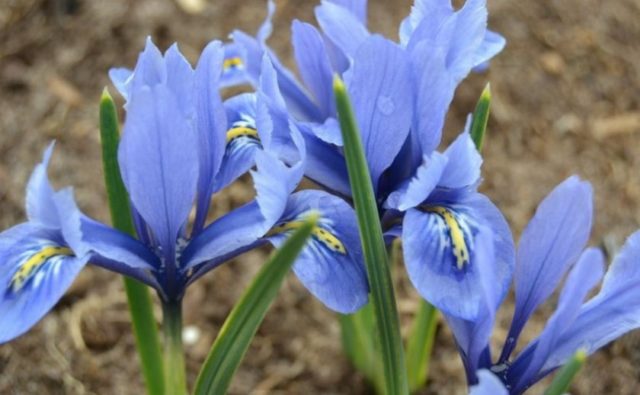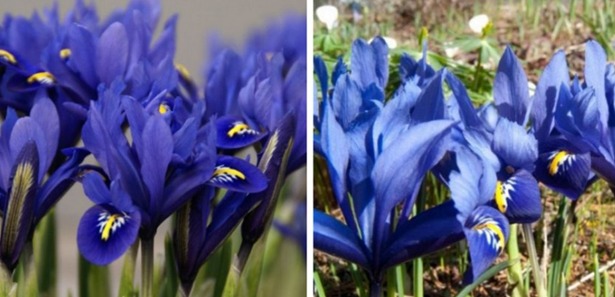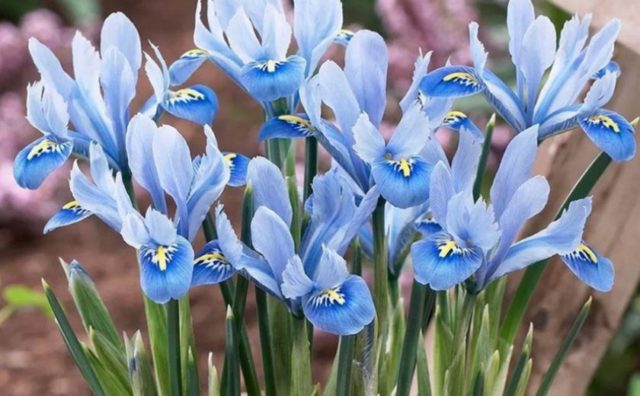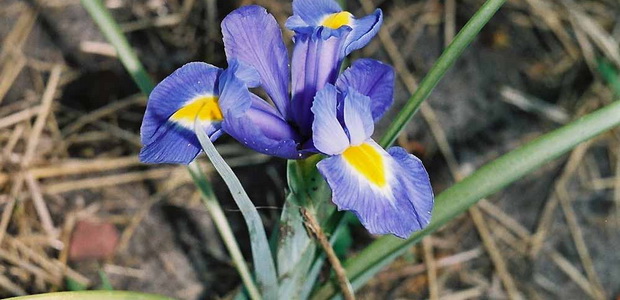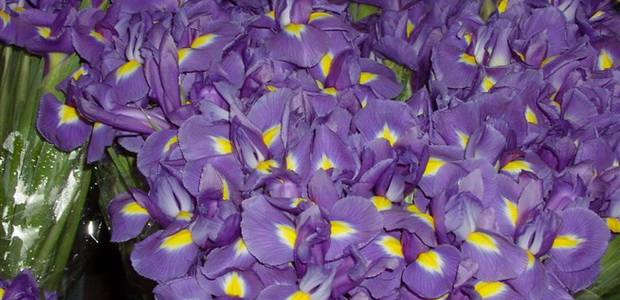Content
- 1 General description of bulbous irises
- 2 Varieties and varieties of bulbous irises
- 3 Application in landscape design
- 4 Breeding methods of bulbous irises
- 5 Planting rules for bulbous irises
- 6 How to grow irises from bulbs
- 7 Do I need to dig up bulbous irises for the winter
- 8 What to do if the bulbous iris rose in the fall
- 9 Forcing bulbous irises at home
- 10 Diseases and pests
- 11 Conclusion
Bulbous irises are short perennials with very beautiful flowers that appear in mid-spring. They decorate the garden well in combination with different flowers, mainly also primroses. When growing, special attention should be paid to the characteristics of the bulbous iris variety: if it is winter-hardy, you do not need to dig out the bulb for the winter. In other cases, it is taken out of the ground and stored in the refrigerator.
General description of bulbous irises
Depending on the type of root system, two groups of irises are distinguished:
- Bulbous.
- Rhizome.
In both cases, the plant has no roots as such: both the bulb and the rhizomes are thickened shoots.
Bulbous irises are short perennial primroses. They begin to bloom profusely from the end of April to the last days of June (in the southern regions - even from the end of March). At the same time, the flowers are partly reminiscent of an orchid in shape. They can have a single or two-tone color. Various shades:
- white;
- cream;
- purple;
- blue;
- blue;
- yellow.

The difference between bulbous and rhizome irises is due to the peculiarities of the structure of the roots.
What iris bulbs look like
The iris bulb is a shortened shoot, shaped like a bud. If you make a vertical cut, you can see the flower arrow in its embryonic state. Around it in layers (like onions) are the rudiments of leaves. They store nutrients and provide plant development and a quick green mass gain.
Axillary and central buds can be seen between the embryos. The last layer is the scales that act as a cover. The width is not very large - 20-35 mm.
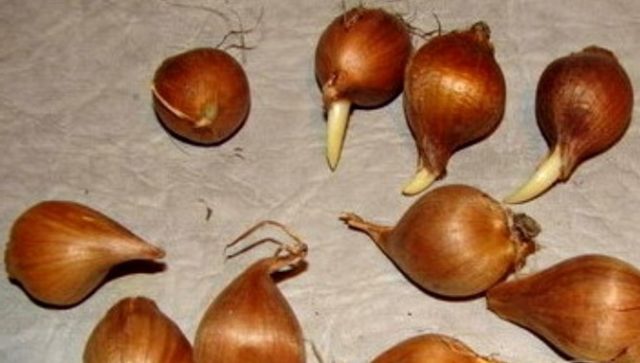
Iris planting material resembles onion sets
Varieties and varieties of bulbous irises
Bulbous irises have several hundred varieties; about 60 varieties are grown in Russia. The most common are 3 types - Juno, Iridodictium and Xyphyum.
Juno
Juno species includes about 50 different varieties of bulbous irises. Such varieties are especially attractive:
- Juno Caucasian - a small, compact flower (25 cm high) growing from a flat, shallow bulb. The flowers are light yellow, asymmetrical, appear at the end of March. The diameter of the flowers is 5-7 cm.
- Juno Foster - another compact bulbous iris with a height of 15-20 cm. Gives several shoots, each of which blooms up to 4 flowers. A very interesting and rather rare variety. Flowers of an unusual two-tone color: violet-yellow.
- Juno of Warile gives relatively tall shoots up to 30 cm with light green leaves (in the rest of the species they are dark). The flowers are purple, in different shades - both light and saturated.
Purple flowers harmonize beautifully with light green leaves
Iridodictium
This is a bulbous iris, which is also called mesh.Blooms for two to three weeks, mainly in late April and early May. Differs in a rich variety of colors - from monochromatic to two-color, with stripes, specks and other patterns.
Bulbous iris (pictured) produces small flowers (5-6 cm in diameter) blue in color.

Mesh iris Iridodictium grows up to 15 cm in height
Among the varieties of Iridodictium, there are such varieties of bulbous irises:
- Kantab - light blue flowers, peduncle height up to 20 cm. The variety is frost-resistant, flowering begins in early April (simultaneously with snowdrops) and continues until the end of the month.
Cantab is a bulbous iris that produces beautiful flowers of a sky-blue hue
- Harmony and Joyce - bloom immediately after the snow melts. The peduncle is low - up to 10-11 cm, sometimes up to 20 cm. The petals are colored in shades of blue and light blue. The variety is distinguished by its high winter hardiness, which allows it to be grown in different regions of Russia. Quite picky about soil fertility and structure.
Iris Harmony produces darker flowers (left) and Iris Joyce produces lighter flowers (right).
- Alida - another frost-resistant iris, giving beautiful blue-blue flowers with a yellow pattern. In the southern regions, it begins to bloom at the end of March. Reproduces well. Despite its small height (10-15 cm), it has rather large flowers up to 8-9 cm in diameter.
Flowers attract attention with pale blue shades and a beautiful pattern
Xyphyum
According to various sources, Ksifium either refers to irises itself, or is a related plant. Flowers have pastel colors with a combination of several colors - blue, purple, yellow, light. The flowers are very attractive, appear in May and June, but they live only a week.
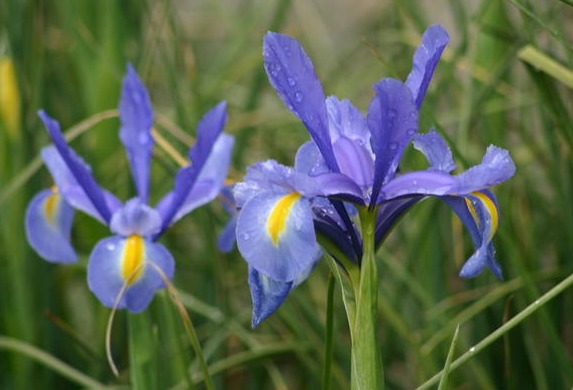
A beautiful yellow pattern is noticeable on the flowers of Xifium, contrasting against a pale blue background.
There are 6 varieties of this bulbous iris. The most popular of which are:
- Xyphyum filamentous - a rather tall plant (up to 45 cm) with purple flowers. The diameter of the flowers is 7-9 cm.
- Xiphium sitnikovidny grows from a large bulb, reaches a height of 30 cm. It blooms mainly in late April - early May, less often in early June.
Flowers of xyphyum sitnikovidny are distinguished by a bright yellow color, so they are clearly visible from all sides of the flower garden
- Xyphyum broadleaf - a very tall (for irises) variety, growing up to 45-50 cm in height. It blooms profusely, gives 2-3 flowers with a diameter of 6-7 cm.
Several irises planted side by side form a beautiful floral carpet
Application in landscape design
In order for bulbous irises to fit into the garden, you need to pay attention to several important points:
- Color combinations, for example, yellow and blue, always look attractive.
- Layering - irises are medium in size, so they can be combined with both taller and shorter plants.
- Flowering period - almost all onion irises are primroses, so it is appropriate to combine them with snowdrops, crocuses, hyacinths, erantis, daffodils, tulips and others.
As for the planting site, irises can be used to decorate any corner of the garden - in flower beds, flower beds, mixborders and other compositions.
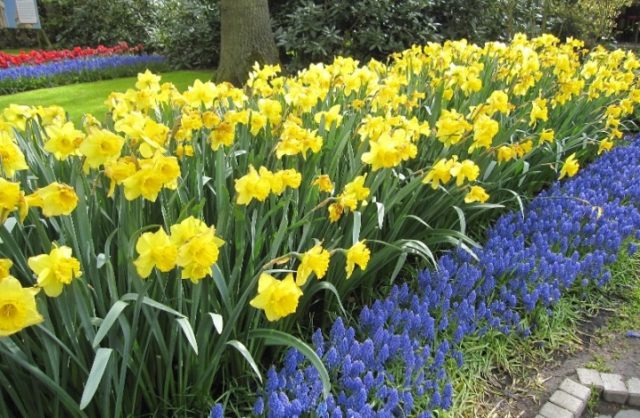
Simple but very harmonious combination of yellow and blue
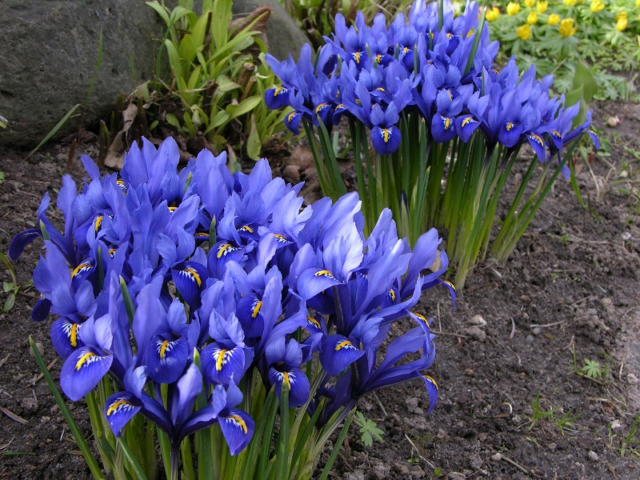
Irises of bright shades look good in single plantings.

Different varieties of irises go well with each other
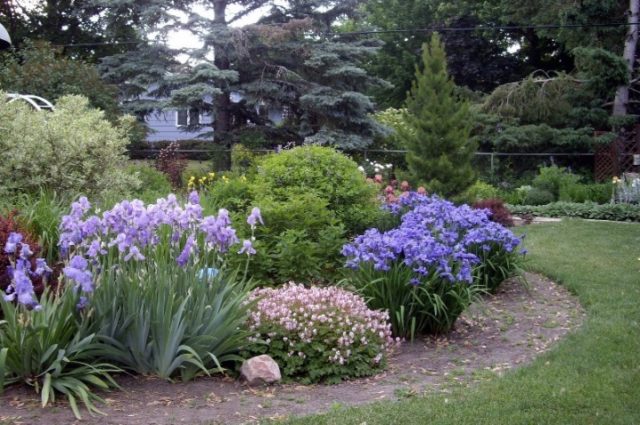
Multi-tiered flower arrangements along the path
Breeding methods of bulbous irises
These plants are propagated by bulbs. After 2-3 years, they give large nests, which contain both large and small bulbs. The bush should be dug out in early or mid-summer and sorted out:
- large ones must be dried in the sun and stored until autumn in a dark, cool room, then planted;
- small ones should be planted immediately in a new place: they will quickly take root, but the first flowers will only give in 2-3 years.
Iris can be grown both as bulbs and seeds. They are planted for seedlings already in February, and the seedlings grow well in normal room conditions.
Planting rules for bulbous irises
A novice florist can also grow an iris from a bulb. At the same time, it is important not only to choose the right place and prepare the ground, but also to determine the timing.
When to plant bulbous irises outdoors
The term depends on the climatic characteristics of the region. In any case, it is optimal to plant bulbous irises in late summer or autumn:
- In the Moscow region and other regions of the middle lane, they are planted in late August or early September.
- In the south, irises can be planted in the second half of October.
- In Siberia and the Urals, the optimal time is the second half of August.
In some cases (for example, planting material was bought in advance), it is allowed to plant irises with bulbs in the spring. But in this case, you first need to keep them in the refrigerator for several weeks, before transferring them to open ground (late April - early May).
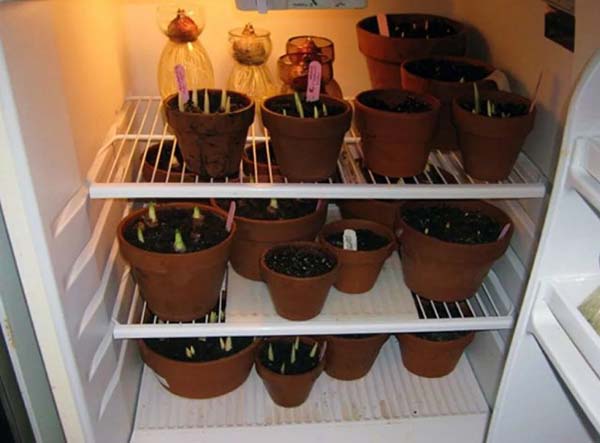
So that the bulbs do not start growing ahead of time, they are kept on the insulated balcony
Site selection and soil preparation
Irises are very fond of light, so the place should be open, without shade. It is good if it will be located on a small hill and in a shelter from drafts, for example, not far from a house, a fence, powerful bushes and trees (while they should not cast a large shadow). Flowers prefer light, fairly fertile soil with a neutral reaction. If the soil is depleted, fertilizer must be sealed in the planting hole.
How to plant bulbous irises
Previously, the bulbs must be kept for several hours in a special etching agent or in a weak 1% solution of potassium permanganate. The landing algorithm is as follows:
- Clean and dig up the area.
- Form planting holes with a shallow depth of up to 8 cm (3 times the height of the bulb) at a distance of 10 cm from each other (3 times the diameter of the bulb).
- Lay a small layer of drainage - small stones, pebbles, expanded clay.
- Cover with pre-prepared fertile soil (you can add superphosphates and potassium salt).
- Root seedlings
- Water abundantly.
How to grow irises from bulbs
Growing and caring for bulbous irises is not very difficult. Like other flower plants, it is important for them to ensure regular watering and feeding.
Watering and feeding
Bulbous irises like regular but moderate watering. If there is precipitation, additional moisture is not needed. And if a drought has come, water should be given 1-2 times a week. After flowering, you do not need to water the culture.
For lush flowering, the plant must be fed:
- For the first time, nitrogen fertilizer is applied immediately after removing the covering material.
- At the stage of bud formation, potassium salt and superphosphates are produced.
- Immediately after the end of flowering, you need to repeat the feeding with potassium and phosphorus.
After that, you do not need to add anything - the irises will no longer bloom, and then the seedling needs to be prepared for the dormant period.
Pruning
The first pruning is done at the end of spring.
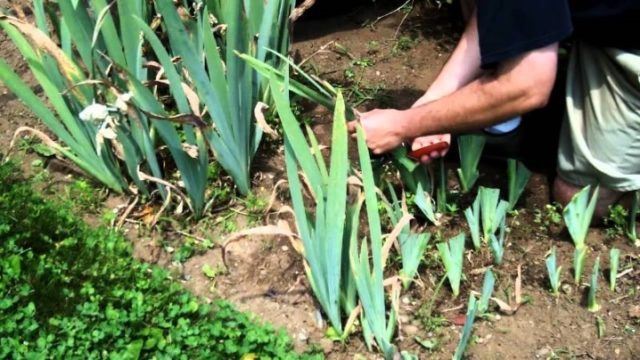
All wilting flowers must be cut
If this is not done, the bulbous iris can suffer from any kind of infection. Dying inflorescences continue to take away some of the nutrients and interfere with other flowers.
The second pruning should be done in September or October, 2 weeks before the first frost. To do this, the leaves are cut in half (there should be 15 cm from the ground) and burned.Then sprinkle with earth.
Preparing for winter
If the variety is winter-hardy (for example, the bulbous iris Kantab or Alida), there is no need to cover it for the winter. All you need to do is trim. If the species does not have good winter hardiness, it is covered with a layer of dry leaves, spruce branches, and covered with spunbond on top. It is not necessary to clog it strongly - otherwise the bulb will begin to rot and may rot.
Do I need to dig up bulbous irises for the winter
The answer to this question depends on the characteristics of the variety and the climate of the region:
- If the winter is warm and snowy enough (southern regions), there is no need to dig up the bulbs - it is enough to mulch them with branches, foliage and spruce branches.
- If the winter is frosty (North-West, Ural, Siberia), the bulbs must be dug up and stored in a dry, cool room.
In the regions of the middle lane, they are guided by the characteristics of the variety - if it is winter-hardy, it is not necessary to dig it up. However, if the fall is too rainy, it is best to remove the iris bulbs and store them until next season in more favorable conditions.
How to dig up bulbous irises
Digging up iris bulbs requires certain rules to be followed. The instruction is as follows:
- The bulbs are carefully dug up and cleaned of soil residues.
- Rinse thoroughly under the tap.
- Store for a month in a dark place at room temperature (to dry).
- Put it into a container (lid with holes), sprinkle it with sawdust or sand with peat, put it in the refrigerator.
Storing iris bulbs
The bulbs are stored in a dry, dark place at a temperature of 3-8 degrees Celsius. To do this, use:
- fridge;
- cellar;
- insulated balcony;
- loggia.
The main condition for storing bulbous irises is to prevent moisture from appearing. Therefore, it is advisable to store them in the refrigerator separately from liquids and food.
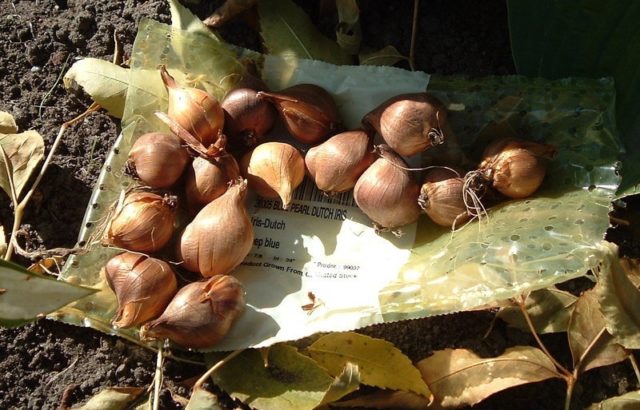
Before storage, iris bulbs are thoroughly dried in the sun or at home.
What to do if the bulbous iris rose in the fall
In this case, cover the bulb with peat, sand or sawdust as soon as possible and put it in the refrigerator or in another dark, cool place. But this is not always possible, so a sprouted iris bulb can be planted in a flower pot and grown as a houseplant. If this option is not suitable, and the bulb continues to grow actively, you will have to part with it. Fortunately, such cases are rarely observed if the storage conditions are observed.
Forcing bulbous irises at home
Forcing is the intentional acceleration of the growth of flowers for the plant to quickly gain green mass and the appearance of the first flowers. In the case of onion irises, the procedure begins with the preparation of the bulbs themselves. After digging them up, they are stored at a special temperature:
- During the first month 30-35 degrees.
- The next 1.5 months - 15-20 degrees.
- Then, within 2-3 weeks, the temperature is reduced to 10 degrees.
The bulbs should be planted 2-2.5 months before the desired flowering period. They begin to grow in a greenhouse at a comfortable temperature of 10-12 degrees. Then it is gradually increased to 18 degrees. Constantly illuminated with a phytolamp so that the duration of daylight hours is at least 14 hours. To accelerate growth (if necessary), the indicator is increased to 16-18 hours.
Diseases and pests
Bulbous irises can be affected by fungal diseases. Most often they reveal:
- septoria;
- fusarium;
- rust;
- heterosporiasis and others.
To prevent this from happening, in the spring they should be treated with any fungicide, for example, Quadris, Fundazol, Fitosporin. Repeated treatments are optional - they will only be needed when signs of disease appear. Also, as a preventive measure, bulbous irises are intensively fed with a mixture of superphosphate and potassium salt.
Among insects, moths, thrips and borers cause particular harm.You can destroy them with an insecticide. For processing bulbous irises, Karbofos, Aktara, Decis, Karate and others are suitable. Invasion of slugs is also often observed. In this case, stone chips or crushed eggshells are scattered next to the flower garden.
Conclusion
Bulbous irises are one of the first to delight with beautiful flowers. In many regions of Russia, the bulbs have to be dug up and stored at home. In the middle lane and in the south, this is not necessary. Caring for these flowers is not very difficult, therefore, if desired, a novice amateur can cope with it.



